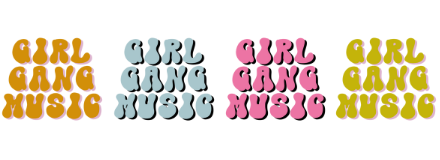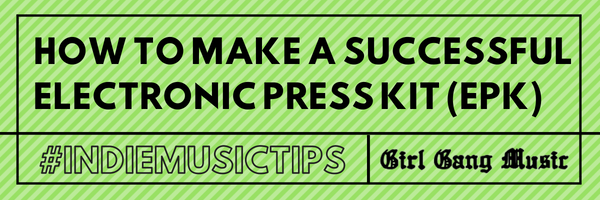Your EPK is your digital pitch to land a job. Much like submitting resumes, it makes more of an impression when your cover letter/resume is specific to the job to which you’re applying.
As an indie artist, your electronic press kit (EPK) serves as a one-stop marketing shop. No matter your current goal with music — whether you’re an original act emailing promoters to book shows, or a function band wanting to get onto the books of a new entertainment agent — you need an EPK.
What is an EPK?
An Electronic Press Kit (EPK) is a document that should showcase what an artist or band’s music is all about.
The most important thing to think about when creating an EPK is to think about who you are giving it to and what THAT audience might want/need from this document. Put yourself in the position of a promoter, potential manager or agent… what information would you want to see?
What should I have in my EPK?
Your EPK should absolutely contain:
- A clear thing you’re selling. If you’re promoting a release, use the single or album art as the main image. EPKs promoting tours could use a tour poster as the main image. If your kit is for booking or other purposes, choose a professional photo of your band as the main image.
- Streaming links to your music. Whoever is reading your EPK should not have to download or receive attachments from you to hear your music. Send links via Dropbox, Soundcloud, YouTube, Spotify – or smart URLs that combine a multitude of options for the listener to find your music. Especially in today’s music consumer landscape, users have preferred streaming services. Meet your listener where they are. It’s also a great idea to embed a music player (that doesn’t autostart).
- Your band or artist biography.
- High res images. Be sure to have a few high quality resolution images in your EPK. If you have a logo, include that here too. PNGs sized 1500 pixels by 1500 pixels or larger are best.
- Links to your website & social medias. Your website should offer additional, in-depth information that clients or potential managers can read, so make sure it is listed in your EPK. Any and all social media links should also be included and remember to keep them updated regularly. Promoters and agents love to use social media to keep a track of how hard-working, busy and popular bands are.
- Contact details. While it is important to include up-to-date contact details for all band members, agents & managers, make sure to specify at least two which are to be treated as the preferred point of contact.
- Tour history and upcoming shows.
Your EPK could be better if it included more things, like:
- A plain text biography. This makes it easy for the user to copy & paste.
- Video content. For both bands and artists, high quality video can make or break if you stand out when applying for opportunities. Having a promotional video lends credibility to you as performers even if it is just a simple video with shots of you performing live and overlaid information about the band/artist.
- Press quotes/clippings. If you have any favorable reviews, make sure to include a select quote from each one (and link to the source).
- Calendar. A list of tour dates, gigs, and performances that should be updated on a regular basis.
- Stage Plot. This one is widely overlooked, but it is extremely useful when planning to play at venues and festivals. The stage plot is a run down of important setup information for your performance. This includes notes for the stage crew on how equipment should be set up, as well as mic inputs and volume settings for the sound engineer. Anything that might be needed to make the show run smoothly. Event coordinators will love you if you have this all figured out beforehand. It makes their job, and yours, much much easier.
- “Sounds Like”/”Recommended If You Like” (RIYL) List. Some people like to see a few examples (no more than five) of contemporary artists/bands you sound like.
What should I avoid with my EPK?
Things you should avoid with your EPK are:
- Requiring downloads or attaching files.
- While you can host your EPK on various hosting sites, or attach a PDF or zip file (which many professionals prefer you NOT do) in an email, it is best to use a folder in a file sharing service (like Dropbox or Box) and share ONE clean link or create single page on your website with anchor links.
- Having broken links or missing files and information. You have one chance!
- Looking like a plain resume. Show your personality!
- Including too much content or too many images/videos. You may feel the urge to include every single one of your band’s releases on a press kit. Too much content overwhelms. Keep it to your simple, top content.
- Being a wise guy/cynical/awkward about reaching out. You may feel awkward even having a press kit to begin with, but music writers are used to receiving press kits all the time. Put on the confidence mask and hit send.
- Unconfirmed plans. Unless clearly stated otherwise, it’s assumed that anything on your EPK is fair game for posting or sharing publicly. So be honest and wait for the ink to hit the paper before you share the news.
What should be include in a music artist or band biography?
Your biography should act as the main storytelling/brand image frame for your artist or band. Most PR experts in the industry suggest having both a long and short version of your biography in your EPK. Long form bios give room to list more in depth information about the artist, and are often hosted on websites. Shorter bios are easier for press to read quickly on air or include in a write-up.
Here are a few ideas on what to include in the artist/band biography:
- Band achievements
- Notable shows, venues, openers
- Endorsements
- Background about the band & its members
- Recent press quotes

